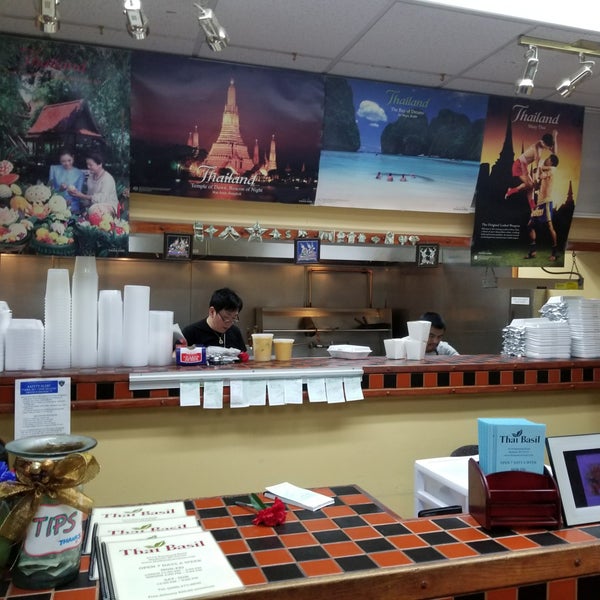

The standard Thai fried rice dish on the menu, also seasoned with plenty of soy sauce, is available in a spicy version and another variant with pineapple. These dishes are also Chinese-influenced, just like many of the stir-fries and fried rice dishes. Noodle dishes include perennial favorites such as pad Thai and wide-bodied models like pad-see-ew with broccoli and egg in oyster sauce and rad nar with vegetables in a thick gravy with a strong note of soy sauce.

The Orange Flavor dish, one step removed from orange chicken, is even more overtly American-Chinese. Other dishes accentuate flavors such as garlic and ginger, showcasing a strong Chinese influence typical of many Thai restaurants in the United States. Expect plenty of the fresh herb in the dish’s name, as well as garlic and a variety of vegetables. This seems to be common across the myriad restaurants under the loosely defined Thai Basil umbrella. Stir-fry dishes, or “sauteed” as they are grouped on the menu, begin with the namesake Thai Basil dish. These same choices apply in the case of most of the entrees, including the curries, which are presented in their usual preparations of red, green, and yellow, as well as panang and massaman varieties.

Both of these, along with crystal noodles and hot-and-sour soups, can be augmented with the diner’s choice of protein: chicken, tofu, pork, beef, shrimp, calamari, or fish. yellow curry with shrimpīig soups suitable for sharing include the Thai restaurant classics tom yum, with its distinctive broth infused with lemongrass, and tom kha,with a thick base of coconut milk. Entree-sized salads include som tum with slivers of green papaya, green beans, and shrimp and grilled beef or prawns with lemongrass, mint, chili, and lime juice all served over lettuce. Crispy sweet potatoes and cheese rolls are less commonly encountered, but fit the fried food bill. Fried tofu, chicken satay, and crisp spring rolls are among the well-prepared crowd-pleasers available at a discount during early dinner hours. The happy hour menu, offered every day except Sunday from 3 until 6 PM, offers most of the regular appetizers at slightly reduced prices. The printed menu covers all the typical Thai bases in terms of curries, stir-fries, and noodle dishes. Others such as basil lamb or roast duck curry give diners a deeper taste of Thai flavors beyond the familiar favorites that predominate on the menu. Some of those dabble in foods like katsu and teriyaki associated with east Asian countries other than Thailand. Upon entering, make sure to turn around and look at several boards where specials are displayed. A small bar is largely used for pickup of takeout orders. Inside, there’s dark wood and natural light. Choose whichever side is shaded at the moment. Small bike racks are found on both the east and west sides of the building. The restaurant is three blocks south of the Rural/University light rail station, and Tempe Streetcar will stop even closer at Rural and Apache when it starts passenger service in 2021. It’s a standalone structure that speaks to another era of car-oriented, stucco-clad buildings that proliferated near the ASU campus before the arrival of the current wave of vertical development. The building appears to be a former chain restaurant of some sort.

The sign over the door says only “Thai Basil.” spring rolls This particular restaurant identifies itself as “Thai Basil ASU” on its website and menus, although the university’s efforts to protect its intellectual property most likely keep “ASU” from becoming part of the establishment’s official name. While the restaurants bearing this name may have a common origin, they have since splintered with different locations now under separate ownership with distinct menus. If the Thai Basil name sounds familiar, it’s because variants of the brand exist throughout the region. Just across from Arizona State University’s Barrett Honors College, a location of Thai Basil is typical of the scattered small businesses that intermingle with chain restaurants and massive new construction projects. It’s decidedly suburban with the potential to become more urban if the city makes the right decisions in the years to come. The segment that runs through Tempe before assuming the name Scottsdale Road north of the Salt River is not only a wide arterial street, but is also teeming with new construction. Rural Road is anything but rural these days.


 0 kommentar(er)
0 kommentar(er)
